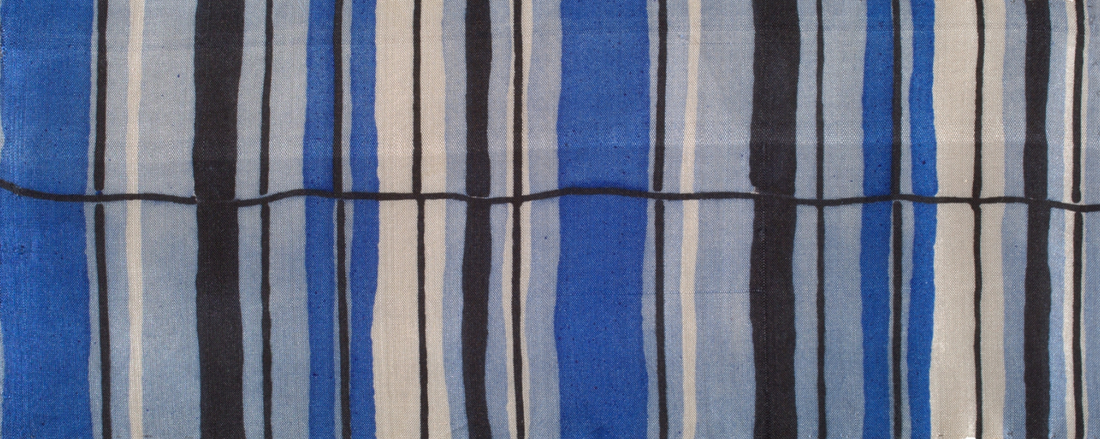
WIENER WERKSTATTE: FROM NATURE TO ABSTRACTION
In the early 1900s, artists of the Wiener Werkstätte (Vienna Workshop) propelled Austria into a prolific center of modern design. The Wiener Werkstätte came to be a powerhouse of Viennese pattern design established by architect Josef Hoffmann and artist Koloman Moser. Dynamic block-printed dress and furnishing fabrics, produced from 1910 onwards, were refreshingly original and eclectic, with patterns ranging from punchy abstracts to zingy florals.
A new exhibition,Wiener Werkstätte: From Nature to Abstraction on show at The George Washington University Museum and The Textile Museum displays fabric samples from these pioneering designers and features the work of George Washington art students inspired by the workshop’s legacy.

Image:Josef Hoffmann (1870-1956); Adler; Austria, Vienna; 1910 (designed), 1912 (reprinted). Cotsen Textile Traces Study Collection T-0193.086. © Bruce M. White Photography. Image above: Maria Likarz-Strauss (1893-1971); Royal; Austria, Vienna; 1928 (designed). Cotsen Textile Traces Study Collection T-0193.166. © Bruce M. White Photography.

Image: Josef Hoffmann (1870-1956); Kohleule; Austria, Vienna; 1910 (designed), 1912 (reprinted). Cotsen Textile Traces Study Collection T-0193.097.© Bruce M. White Photography.
In the publication that runs alongside the exhibition, Tracing Wiener Werkstätte Textiles: Viennese Textiles from the Cotsen Textile Traces Study Collection, eleven authors trace the history of the world-famous and innovative fabrics designed by the Wiener Werkstätte. Their studies focus on aspects such as the origins of textile and fashion design collections and archives in Austria, Switzerland and the United States; the importance of Eastern European folk art, Japanese stencils, and didactic books on ornament of the late 19th century for Wiener Werkstätte textile patterns; the practical application of Wiener Werkstätte textiles in fashion, interior design, film and theater sets; and the workshop's strategies for conquering new markets in the United States. Three of the contributions provide new insight into the work of previously little-noticed female artists Hilda Schmid-Jesser, Maria Likarz-Strauss and Mizzi Vogl.

Image: Maria Likarz-Strauss (1893-1971); Asunta; Austria, Vienna; 1929 (designed). Cotsen Textile Traces Study Collection T-0193.175. © Bruce M. White Photography.
Wiener Werkstätte: From Nature to Abstraction is on at The George Washington University Museum and The Textile Museum.

Image: Dagobert Peche (1887-1923); Falte; Austria, Vienna; 1920-1923 (designed). Cotsen Textile Traces Study Collection T-1857.© Bruce M. White Photography.
Find out more:
museum.gwu.edu
Read more about the Wiener Werkstätte and their influence on textile design in Selvedge issue 74 (Perennial Prints: Josef Frank’s Striking Botanicals), and issue 97 (Viennese Whirl: Emilie Flöge Designing for Klimt).
A new exhibition,Wiener Werkstätte: From Nature to Abstraction on show at The George Washington University Museum and The Textile Museum displays fabric samples from these pioneering designers and features the work of George Washington art students inspired by the workshop’s legacy.

Image:Josef Hoffmann (1870-1956); Adler; Austria, Vienna; 1910 (designed), 1912 (reprinted). Cotsen Textile Traces Study Collection T-0193.086. © Bruce M. White Photography. Image above: Maria Likarz-Strauss (1893-1971); Royal; Austria, Vienna; 1928 (designed). Cotsen Textile Traces Study Collection T-0193.166. © Bruce M. White Photography.

Image: Josef Hoffmann (1870-1956); Kohleule; Austria, Vienna; 1910 (designed), 1912 (reprinted). Cotsen Textile Traces Study Collection T-0193.097.© Bruce M. White Photography.
In the publication that runs alongside the exhibition, Tracing Wiener Werkstätte Textiles: Viennese Textiles from the Cotsen Textile Traces Study Collection, eleven authors trace the history of the world-famous and innovative fabrics designed by the Wiener Werkstätte. Their studies focus on aspects such as the origins of textile and fashion design collections and archives in Austria, Switzerland and the United States; the importance of Eastern European folk art, Japanese stencils, and didactic books on ornament of the late 19th century for Wiener Werkstätte textile patterns; the practical application of Wiener Werkstätte textiles in fashion, interior design, film and theater sets; and the workshop's strategies for conquering new markets in the United States. Three of the contributions provide new insight into the work of previously little-noticed female artists Hilda Schmid-Jesser, Maria Likarz-Strauss and Mizzi Vogl.

Image: Maria Likarz-Strauss (1893-1971); Asunta; Austria, Vienna; 1929 (designed). Cotsen Textile Traces Study Collection T-0193.175. © Bruce M. White Photography.
Wiener Werkstätte: From Nature to Abstraction is on at The George Washington University Museum and The Textile Museum.

Image: Dagobert Peche (1887-1923); Falte; Austria, Vienna; 1920-1923 (designed). Cotsen Textile Traces Study Collection T-1857.© Bruce M. White Photography.
Find out more:
museum.gwu.edu
Read more about the Wiener Werkstätte and their influence on textile design in Selvedge issue 74 (Perennial Prints: Josef Frank’s Striking Botanicals), and issue 97 (Viennese Whirl: Emilie Flöge Designing for Klimt).
